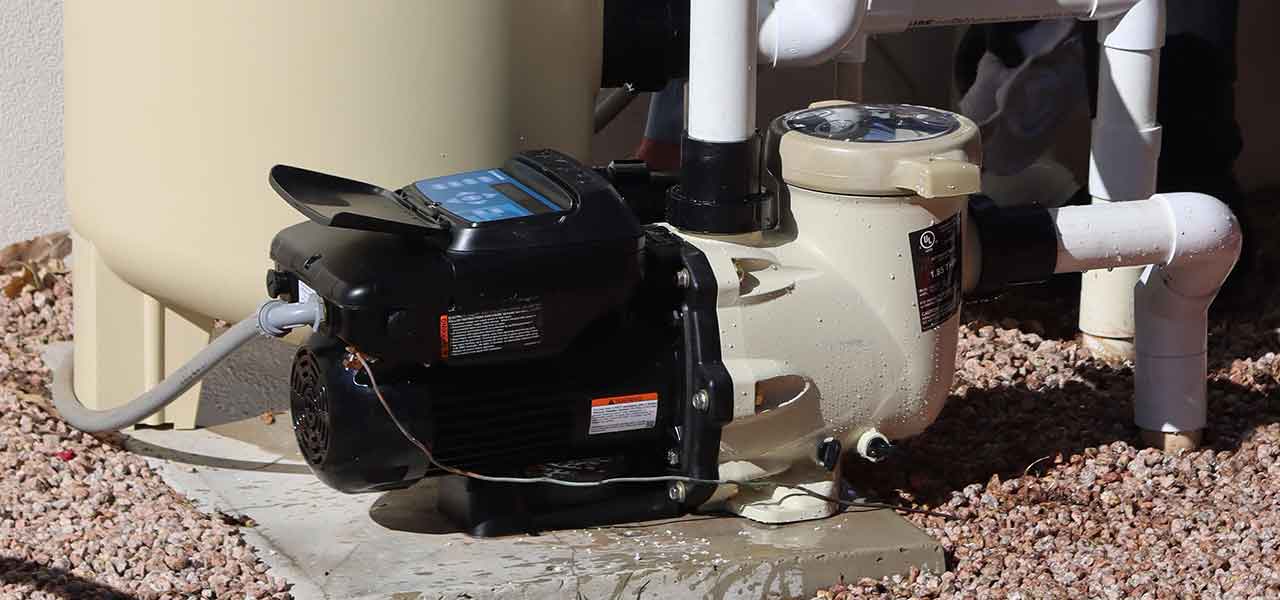FREE Standard Shipping On All Orders $100 or More!*

11 Ways to Destroy Your Pool Pump
A pool pump is the heart of any swimming pool, playing a crucial role in circulating and filtering water to maintain cleanliness and clarity. Understanding the significance of a pool pump is essential for every pool owner, but equally important is recognizing the potential threats that can compromise its efficiency. Various factors, if not carefully managed, can lead to the destruction or damage of pool pumps.
Let’s delve into the potential hazards that could compromise your pool pump’s functionality and essential tips on ways to safeguard it.
1. Frozen Pool Pump

Problem: Water expands 9% when it turns into ice, and this can rupture a pool pump volute or strainer housing, causing cracks that require part replacement.
Solution: Keep the pump running during cold temperatures. As long as water is moving through the pipes, nothing will freeze. If it is not possible to run the pump, remove both pump drain plugs (and filter plugs, heater plugs, chlorinator, etc.). With freeze protection for pool equipment, a pool controller or a digital time clock can use a freeze sensor, which will turn on the pump automatically.
2. Flooded Pool Pump
Problem: When motors are submerged underwater, drowning is usually fatal. Occasionally a partially submerged motor will survive, if taken apart and dried internally, unless it was running at the time of the flooding! Many pumps start out their lives well above the ground, but over years, sediment and debris can raise the ground until there is very little clearance.
Solution: Raise the pump, or lower the ground! Be sure that the area around your pool equipment drains rapidly during heavy rains. If flood waters threaten your pool pump, sand bag the pad, or remove the pump to higher ground until waters recede. If water no longer runs away from the equipment quickly, dig out any in-fill or soils that have washed up against the pad, grading slopes and swales to carry water away. Add gravel around the pump and filter area to reduce moisture and slow weed growth.
3. Dry Pool Pump

Problem: Pumps that 'run dry' (without incoming water) for long periods can blow out the shaft seal and begin leaking. In some cases, it will melt pump baskets and even deform the pump volute. Resulting high temps also will shrink the threads on PVC fittings threaded in/out of the pump, causing air leaks on the inlet side, and water leaks around the outlet pipe fitting.
Solution: Maintaining a proper water level in the pool is the first advice. Secondly, hunt down and fix any air leaks on the incoming pipes or suction cleaner hoses, which can cause the pump to lose prime. Finally, be sure that the pump lid is lubed and tight, and drain plugs are Teflon taped and tight. The other common air leak is around melted and shrunk PVC fittings threaded into the pump, as mentioned above. Replace the shrunken fitting, or make a patch with Pool Putty.
4. Wet Pool Pump
Problem: Bushes, weeds and overhanging trees trap moisture and restrict air flow around pool pumps. Soil and mulch around pumps and low areas trap water and moisture. Pump motors will last longer in dry conditions.
Solution: Trim bushes and plants as needed to reduce moisture and increase air flow. Use gravel and remove or spray weeds regularly, to keep the pump area a plant-free zone.

5. Hot Pool Pump
Problem: Motors need good air circulation to stay cool while running, which also helps a pool motor last longer. Plants, mulch or enclosed spaces block the breeze. Direct sun will also raise motor temperature.
Solution: Motors are always hot to the touch, running at around 140ºF. Good air circulation reduces motor temps. Pump motor shields can be used to block sunlight.
6. Wrong Size Pump
Problem: Pumps that are too big for the pipe size or number of incoming pipes will cavitate under excessive vacuum pressure, essentially starved for water. And pool pumps that are too small for the system will struggle against a heavy resistance pressure. In both cases, the pump and motor is overworked; a leading cause of heart (pump) failure.
Solution: Select new pool pumps based on a careful consultation of the Pump Flow Curve, with a good estimate of your system resistance, and the knowledge of your Filter Design Flow Rate. Replacing with the exact duplicate pump is a good bet, or an IntelliFlo or EcoStar variable speed pump can be optimized to match system resistance.
7. Wrong Pump Wiring
Problem: Incorrect voltage, wire size or wiring. High or low voltage over time can stress the motor, or just flat burn it out, causing a short across the windings or blowing out the capacitor repeatedly. Pool motors are available in 120V and 240V (only), and also 120V/240V, known as reversible motors, able to accept either voltage. Connecting 120V into a motor that is expecting 240V just won't start the motor, but putting 240V into a motor wired for 120V and you can expect sparks and smoke and a dead motor if not shut off quickly! Mis-wired motors, or using incorrect wire size could also cause motor problems.
Solution: Line voltage should be stable and within 10% of 115V or 230V, whichever is used. When installing a new motor, double check that line voltage matches motor voltage. Read the wiring diagram closely on the motor label to be sure that your power leads and ground wire are correctly attached to the terminal board. Although modern motors are fairly straight-forward with the power connection, it is possible to mis-wire a motor. And, if replacing old wires, be sure to use the correct wire size, usually 12/3, or 12 AWG size, three wires, usually white, black and green.

8. Insect Infestation
Problem: Insects can chew through wires or can short out circuitry as they seek the warmth and shelter of the pump motor, becoming a conductor between two metals that should not touch. This can happen in the rear of the pump motor, or in the time clock or control panel. Wasp or hornets nests can also make a mess.
Solution: Use insecticide as needed. Seal up any open knock-outs, and block any other access points to control panels and motors.
9. Heavy Mulch
Problem: Mulch is very acidic and traps moisture, creating an acrid humid air around the pump motor, which can be corrosive to metallic pump parts. And when each spring another 2" of mulch is laid down, over time this raises the ground level, reducing air flow and in some cases increasing the chances of flooding the pool pump.
Solution: Use gravel, not mulch around your pool equipment. Use a rake or leaf blower regularly to remove sticks, leaves or 'natural mulch'.
10. Heavy Snow

Problem: Pool pumps under a pile of snow cannot breathe. Moisture becomes trapped inside the motor when there is no air circulation. Repeated freeze/thaw cycles creates internal rust between the stator and rotor, causing motors to 'lock-up' come spring. Avoid extended periods of heavy snow; small amounts pose little concern.
Solution: Use an upside down Rubbermaid container, or laundry basket to cover the pump, cut out on side to fit snugly over the pump and/or motor. Be sure to allow for sufficient air flow on all sides, so as not to trap moisture inside. For the same reason, never wrap a motor tightly in plastic. An even better method is to install pool pump unions for easy winter removal, and indoor storage.
11. Heavy Branches

Problem: Heavy branches that fall, just right across a pool pump motor or on top of the pump lid, can do considerable damage to pool pumps. Not often, but it happens occasionally.
Solution: Trim branches as needed.
Good pool pump maintenance ensures a healthy heart for your pool circulation system and prevents premature "heart failure," which can happen during the hottest week of the summer.